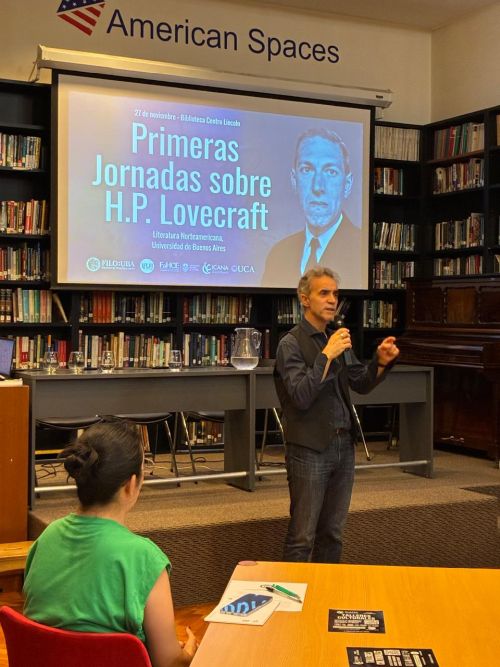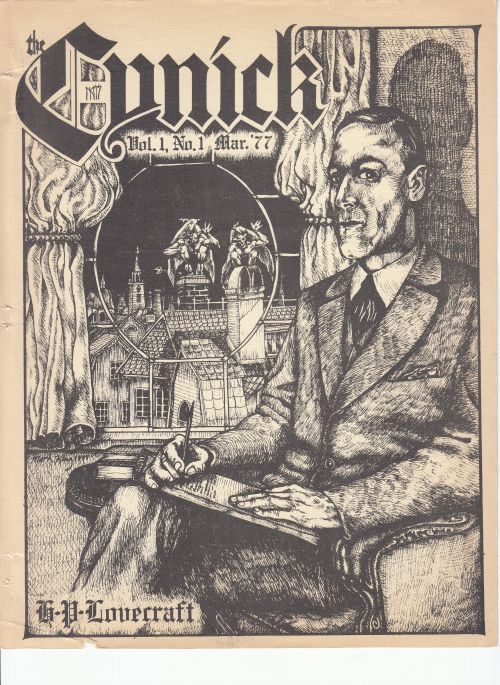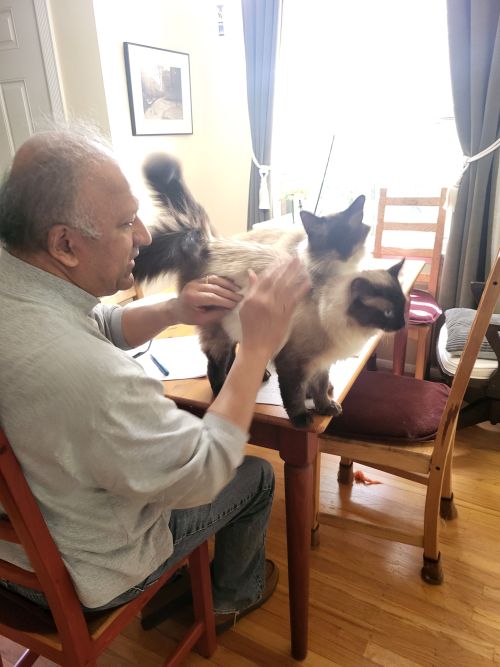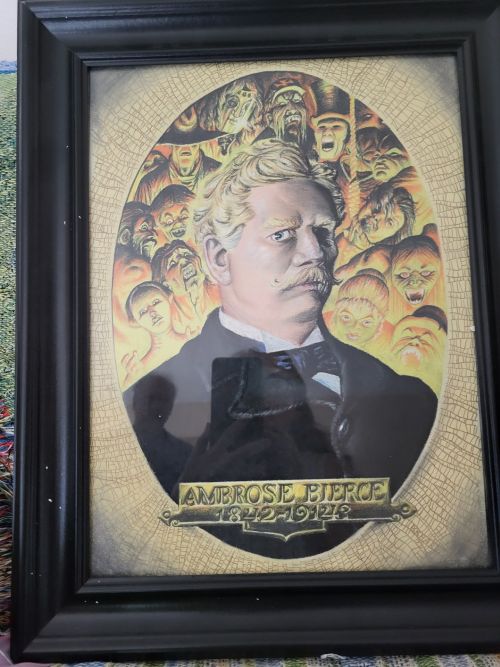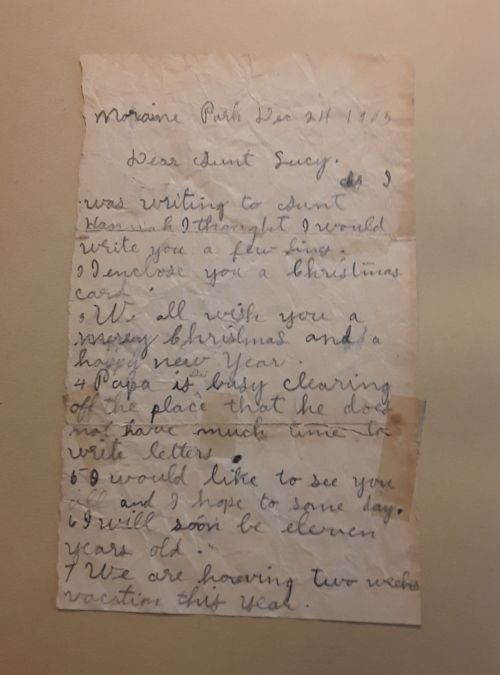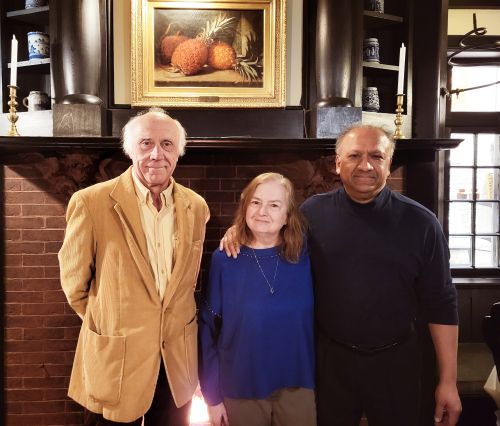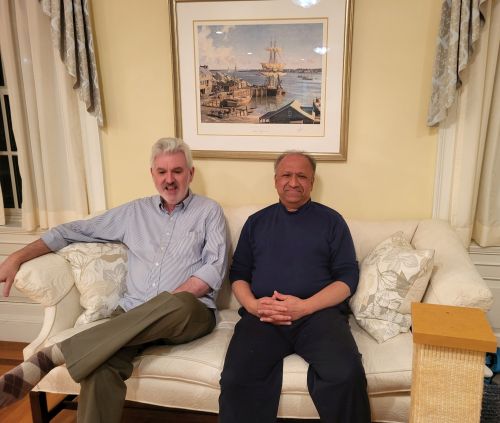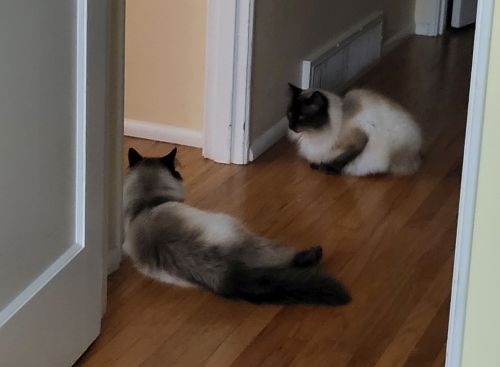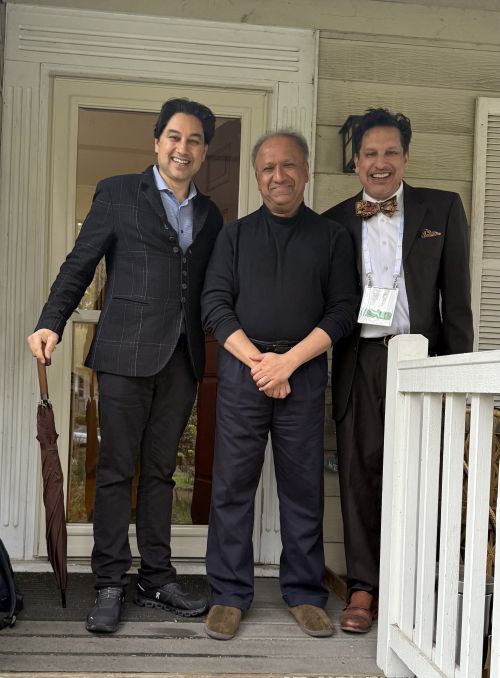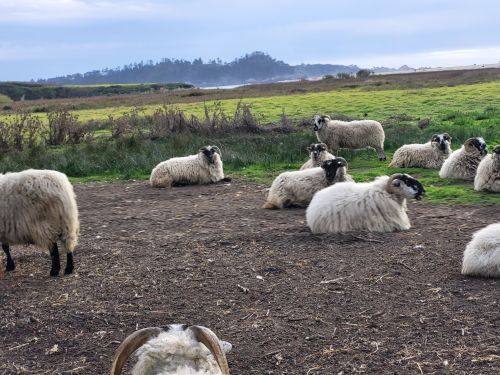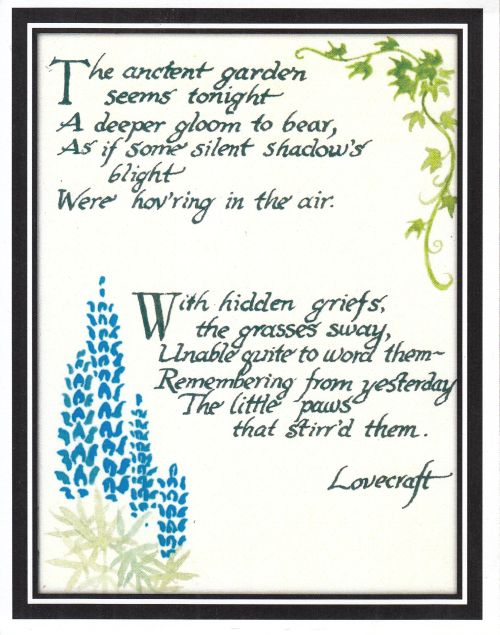S. T. Joshi’s Blog
December 9 2025 —The Weird Fiction of Arlton Eadie
I am proud to announce the publication of the first of two volumes of the weird stories of Arlton Eadie, The Nameless Mummy and Others (https://www.amazon.com/dp/B0G2JCBL6T). I was alerted to Eadie’s extensive contributions to the genre (mostly in Weird Tales, but also in a few other pulp magazines of the period) by a colleague, Jim Oldenburg, who pointed out that Eadie (1886–1935) was one of the relatively few English writers to appear regularly in the American pulp magazines. Some of the stories in my volume first appeared in Hutchinson’s Mystery Story Magazine in Great Britain. Many of his stories have a distinctively English feel to them (one of them, “The Immortal Hand,” involves the resurrection of the hand of William Shakespeare)—which makes me wonder why the devout Anglophile H. P. Lovecraft didn’t find them worthy of note. But I find almost no mentions of Eadie in his surviving correspondence. In any event, this volume and its successor (due out early next year) constitute the first time that his weird work has been gathered in book form.
Another publication of interest is August Derleth’s When Imagination Ends: Essays on Speculative Fiction, published by the August Derleth Society (https://www.amazon.com/dp/B0G24HGWJQ). This is an extensive selection of Derleth’s writings on weird, fantasy, and science fiction, taken from a disparate array of sources: extracts from the treatise Writing Fiction (1946); articles and reviews in the Arkham Sampler (1948–49); introductions to his various anthologies of the 1940s and 1950s; and even an unpublished article or two, such as “My Twenty Years with Ghosts” (1959), an essay dealing with his publication of weird writers with Arkham House. There is a selection of Derleth’s writings on Lovecraft, as well as his discussions of the founding of Arkham House, culminating with the essay on Arkham House’s establishment and progress found in Thirty Years of Arkham House (1970), one of his last published writings.
I am at work on numerous other volumes for Sarnath Press. Next year may see me publish several volumes of mystery/detective fiction, but weird fiction—and the criticism of weird fiction—will not be ignored. I am slated to publish John Carter Tibbett’s collection of Halloween-related stories, Pumpkin Seeds, along with Pierre Déléage’s profound monograph on R. H. Barlow, which delves deeply into Barlow’s anthropological work in Mexico along with a discussion of his weird fiction and poetry.
I was pleased to hear of the success of a recent conference on Lovecraft held in Buenos Aires, Argentina. I was asked to provide a brief video greeting to the attendees, which I did; and its organiser, Marcelo G. Burello, a professor at the University of Buenos Aires, has sent me a photo of the opening ceremonies (I assume it is he who is pictured here):
One more sign that the worldwide interest in Lovecraft shows no signs of abating!
November 12, 2025 — New Hippocampus Books
I am happy to announce the arrival of four new publications from Hippocampus Press, which I can offer at a slight discount from the retail price:
- Penumbra No. 6 (Autumn 2025) ($10)
- Algernon Blackwood, The Wendigo and Others (Collected Short Fiction, Volume 3) ($25)
- Katherine Kerestman and S. T. Joshi, ed., Witches and Witchcraft ($20)
- Maxwell I. Gold, Songs of Enough ($10)
This issue of Penumbra contains six original stories (by Dmitri Akers, Aditya Dwarkesh, Maureen O’Leary, Manuel Arenas, Mark Howard Jones, and Joshua Green); five substantial articles (John C. Tibbetts on Saki; Mario Sánchez Gumiel on the Spanish weird writer Pompeu Gener; John P. Irish’s article on Dickens, Poe, and Fitz-James O’Brien; Ramsey Campbell’s “Ramsey’s Rant”; and my article on Ramsey Campbell’s “Made in Goatswood”); seven original poems; and four reviews, previously scheduled for Dead Reckonings. The Blackwood volume contains some of his most powerful fiction, including the title story, “The Glamour of the Snow,” “The Man Whom the Trees Loved,” and “Sand.”. The Gold book is an extraordinary excursion into cosmic prose-poetry—one you are not likely to forget.
Please note that I still have two copies of volume 3 of the Chiroptera Press edition of Lovecraft’s collected fiction, available for $75.
I am in receipt of Jan B. W. Petersen’s H. P. Lovecraft: Midnight Studies (Peter Lang, 2024) (https://www.janbwpedersen.com/h-p-lovecraft-midnight-studies), a series of essays by one of the most perspicacious recent commentators on Lovecraft. I wrote a brief foreword to the book. Several chapters appeared in the Lovecraft Annual, but they are here presented as segments of a unified study.
Another remarkable publication that has come in is The Cats of Ulthar: A Tale Reimagined, a graphic adaptation of “The Cats of Ulthar” by Bruce Brown (https://www.amazon.com/Cats-Ulthar-Reimagined-Bruce-Brown-ebook/dp/B0FMC1X9J1). The artwork in this item is truly remarkable, and every devotee of Lovecraft (and of felines) should pick it up!
Yet another item that has come in is M. G. Turner’s Reader Faustus: A Novella in Verse (https://www.magersandquinn.com/product/READER-FAUSTUS/28710085). I have previously reviewed Turner’s Dreams of the Romantics, and I suspect this volume—a poetic interpretation of the Faustus cycle—is as engaging a read as its predecessor.
Finally, I wanted to bring to your attention a comment that Martin Andersson—who knows a lot more about Lord Dunsany than I do—made in reference to my quotation, in my previous blog post, of a passage from a P. G. Wodehouse novel that I thought referred to the 18th baron. But Martin has corrected me. He writes: “I do not think the reference is to Lord Dunsany but to his brother, Sir Reginald Aylmer Ranfurly Plunkett-Ernle-Erle-Drax (when inheriting his mother’s estates, he was required to add some surnames)—the ‘Ernle’ seems to indicate it. He was well-known for his quadruple-barrelled name at the time, but usually went by ‘Drax.’” Someone should write a new biography of Lord Dunsany, since Mark Amory’s 1972 book is woefully inadequate. Why not Martin?
November 3, 2025 — Clark Ashton Smith Biography Finished
I am proud (and, in all honesty, relieved) to announce the completion of the initial draft of my biography The Star-Treader: A Life of Clark Ashton Smith. Here is the table of contents of the book:
- Preface
- I. Autodidact:1893–1910
- II. Poetic Genius:1911–1912
- III. Verse and Prose:1913–1918
- IV. Cosmic Consciousness:1919–1922
- V. On Boulder Ridge:1923–1928
- VI. Prose Fantasies:1929–1930
- VII. Super-Scientific Tales:1931–1932
- VIII. Zothique and Others:1933–1935
- IX. More Living Than Writing:1936–1942
- X. Hell-Black Wizardries: 1943–1949
- XI. The Sorcerer Departs:1950–1961
- XII. A Very Great Man:1962–2025
- Bibliography
- Index
I am now in the process of reading through the entire text (which currently comes to 164,356 words), looking for errors, omissions, inconsistencies, infelicities of all sorts, and other blemishes. Mary is also reading through the text, as she always catches things that I miss. Aside from the text, the book could include as many as 16 photographs relating to Smith.
The book is dedicated to Donald Sidney-Fryer. I expect to have at least one provisional copy of the work available for the one-day Clark Ashton Smith conference that will take place on January 10 (https://www.thesmithcircle.net/). This is probably the only convention I will attend next year. The actual book, of course, will be published in the summer of 2026 by Hippocampus Press.
Another important development is the publication via Sarnath Press of my edition of J. D. Beresford’s complete speculative short fiction, titled Powers of the Air (https://www.amazon.com/dp/B0FX75TWM9). I had been impressed with this English writer’s work ever since I stumbled upon the story “A Negligible Experiment” (in Signs and Wonders, 1921), which included in my anthology Great Tales of Terror (Dover, 2002). Recently I read through Beresford’s other story collections—Nineteen Impressions (1919), The Meeting Place and Other Stories (1929), and several others—along with uncollected stories, to arrive at what I believe to be a definitive gathering of his tales of horror, fantasy, and science fiction. I hope you will find the material as stimulating as I have. Go pick it up!
I am in receipt of a new LP from Cadabra Records, a rendering of Georges Bataille’s novella Story of the Eye (L’Histoire de l’oeil, 1928). The LP does not appear to be listed on the Cadabra Records website yet, but here is a site that gives some information: https://www.discogs.com/release/35439892-Georges-Bataille-Read-By-Laurence-R-Harvey-Score-By-S-F-F-S-Chris-Bozzone-Story-Of-The-Eye. I wrote the liner notes for the LP, finding much interest in the work—which, of course, is in no way a weird tale, but rather a social and religious satire with a substantial sexual undercurrent.
To conclude this brief blog post, I was amused to be alerted (by my learned neighbour Jim Dempsey) to a curious passage in P. G. Wodehouse’s novel Pigs Have Wings (1952). This is a Lord Emsworth/Blandings Castle novel, and one passage features a discussion in which a character cannot remember the name of a new secretary (male) he has hired: “Smith? Jones? Brown? Cholmondeley-Marjoribanks? Vavasour-Dalrymple? Ernle-Plunkett-Drax-Plunkett?” That last name (except for the “Ernle”) is manifestly a reference to Edward John Moreton Drax Plunkett, Eighteenth Baron Dunsany, who was still alive at this time (he would not die until 1957). I am not aware that the two authors were acquainted; but no doubt Wodehouse used this name for its comic overtones. In the end, not a bad tribute!
October 21, 2025 — Action on Multiple Fronts
There is already a great deal to discuss, as numerous developments have occurred in a number of areas in which I am interested. First, the podcast that I conducted with Daniel James Sharp pertaining to volume 2 of my Downfall of God is now available on YouTube: https://www.youtube.com/watch?v=5Zh3EEBl__M. The podcast went on for about an hour, and there was lively discussion with a number of the listeners—which included some notable figures in the realms of atheism and freethought, including Bob Forder, Bill Cooke, and others.
On a related note, I have received the September–December 2025 issue of the Truth Seeker, founded in 1873 by D. M. Bennett and currently edited most capably by Roderick Bradford (https://thetruthseeker.net/). The issue contains an extract from volume 2 of The Downfall of God.
I expect copies of the book to reach me within weeks; Amazon announces that the official publication date of the book is November 17.
I am in receipt of volume 3 of the Chiroptera Press reprint of Lovecraft’s Collected Fiction: A Variorum Edition. I would be happy to let my copies go for $75 to interested customers. The price is a slight discount from the list price of $80.
Another interesting item that has come in is Catherine Koeckx’s A Guide to Lovecraft’s Providence (https://www.amazon.com/Guide-Lovecrafts-Providence-Catherine-Koeckx/dp/B0DLTYCNDC), a 131-page booklet with numerous full-colour illustrations of important sites relating to Lovecraft in his native city. This book (which I believe first appeared in French) is well worth securing for any devotee of Lovecraft.
Yet another item is Splinters of Azathoth and Other Stories by Mike Slater and Miguel Fliguer (https://www.amazon.com/SPLINTERS-AZATHOTH-STORIES-Miguel-Fliguer/dp/B0FP5G9VL6), which contain twenty stories in the distinctive subgenre of “culinary horror.” I have not read this book as yet, but the authors have done good work in the past, so I imagine this volume is as entertaining as its predecessors.
An important publication relating to August Derleth is The Early Years: Stories of Young Love, just published by the August Derleth Society (https://www.amazon.com/dp/B0FVT24XKZ). Aside from including numerous stories relating to Derleth’s early love affair with a high school student he names Margery (based upon an actual classmate in Sauk City High School in the 1920s), the book contains the previously unpublished “Marius”—a novella that recounts, with exquisite delicacy and sensitivity, a homosexual relationship between two male protagonists in high school and beyond. It was written in 1952 and is a sort of fantasised version of Derleth’s relationship with Mark Schorer, his early collaborator on weird tales, who went on to become a distinguished professor, novelist, and critic. The book also contains a short article on Derleth by Schorer, as well as other documents (including letters by the actual “Margery”) that shed light on all these relationships. This book reveals a new side of Derleth that should allow for a significant re-evaluation of both his life and his literary output.
I have now completed the second-to-last chapter of my biography of Clark Ashton Smith, covering the final decade of his life; all that remains is to discuss the sixty-plus years that have passed since 1961, tracing the wide dissemination of his work and other matters. The book has come to 156,000 words, and I hope (as, I suspect, does my publisher, Derrick Hussey) that this final chapter does not add too much to that total.
And, to end this blog post on both a happy and an artistic note, take a gander at this wonderful photo of our cat Dante as he all but poses for a full-length portrait:
He and his brother Renzo continue to be the joy of our lives!
October 9, 2025 — Fire Sale, October 2025
Before coming to the main subject of this blog post, I would like to announce an important event in which I will soon be participating: a podcast concerning volume 2 of The Downfall of God, hosted by an English freethinker, Daniel James Sharp: https://freethinker.co.uk/2025/08/freethought-history-webinar-5-a-brief-history-of-the-downfall-of-god-with-s-t-joshi-14-october-2025/. I believe one has to sign up for this event, which will take place on October 14. I hope to see many of you there!
Now, on to the fire sale. I have not held one of these sales in some time—but the books keep on piling up here, and I must make some headway in disposing of them. So I am offering the following titles for the bargain price of $5 each! Many of these are Hippocampus titles; those that are not are identified with the publisher’s name and date of appearance. Please note that in most instances I have very few copies available for any given title:
- Leigh Blackmore, Spores from Sharnoth and Other Madnesses (P’rea Press, 2013)
- Adam Bolivar, The Lay of Old Hex
- Irvin S. Cobb and Gouverneur Morris, Back There in the Grass
- Gary William Crawford et al., ed., Reflections in a Glass Darkly: Essays on J. Sheridan Le Fanu
- August Derleth, The Dark House and Cassandra (August Derleth Society, 2024)
- August Derleth, Poems of Sac Prairie, Volume 2 (August Derleth Society, 2024)
- Ashley Dioses, Diary of a Sorceress
- Jason C. Eckhardt, The Legions of the Sun
- Wade German, Dreams from a Black Nebula
- Salomé Jones, Cthulhu Lives! (Ghostwoods, 2014)
- S. T. Joshi, ed., Black Wings of Cthulhu 5 (Titan Books, 2018)
- S. T. Joshi, ed., The Cold Embrace: Weird Stories by Women (Dover, 2016)
- S. T. Joshi, ed., The Red Brain: Great Tales of the Cthulhu Mythos (Dark Regions Press, 2017)
- Katherine Kerestman, Haunted House and Other Strange Tales
- Robin D. Laws, ed., Shotguns v. Cthulhu (Stone Skin Press, 2012)
- Ross E. Lockhart, ed., Cthulhu Fhtagn! (Word Horde, 2015)
- Lovecraft Annual 4 (2010), 5 (2011)
- Lovecraft Annual No. 18 (2024)
- Lovecraftian Proceedings 4
- Lovecraftian Proceedings 5
- James Lowder, ed., Madness on the Orient Express (Chaosium, 2014)
- Heather Miller, Ripples from Carcosa
- Penumbra No. 5 (2024)
- Fred Phillips, Winds from Sheol
- W. H. Pugmire, Some Unknown Gulf of Night (Arcane Wisdom, 2011)
- Joseph S. Pulver, Sr., Blood Will Have Its Season
- Joseph S. Pulver, Sr., Portraits of Ruin
- Joseph S. Pulver, Sr., Sin & Ashes
- Ann K. Schwader, Dark Energies (P’rea Press, 2015)
- Donald Sidney-Fryer, Aesthetics Ho!
- Franklyn Searight, Lair of the Dreamer
- May Sinclair, If the Dead Knew
- Clint Smith, The Skeleton Melodies
- Jeffrey Thomas, Haunted Worlds
- Jonathan Thomas, Naked Revenants
- Edward Lucas White, The Stuff of Dreams (Dover, 2016)
As an inducement to purchase the above titles, I will supply the following titles for free, and you are welcome to request as many of them as you wish, so long as you purchase at least one title from the above list:
- Dead Reckonings 9, 12, 15, 21, 22, 24, 26, 27, 29, 35
- Spectral Realms 1, 7
I also have a few titles that are a bit more in the way of collector’s items, with prices for each appended. In every instance I have only one copy for sale:
- Cynthia Ceilán, Thinning the Herd (Michael O’Mara, 2008) [hc] [$10]
- Pete Crowther and Nick Gevers, ed., Unfit for Eden (PS Publishing, 2012) [$20]
- Pete Crowther and Nick Gevers, ed., Edison’s Frankenstein (PS Publishing, 2009) [$30]
- Paul Guran, ed., New Cthulhu 2 (Prime, 2015) [$10]
- T. E. D. Klein, Dark Gods (Chiroptera Press, 2024) [$150]
- Stephen Mark Rainey, Other Gods (Dark Regions Press, 2008) [signed pb] [$20]
- Brian J. Showers, The Bleeding Horse and Other Ghost Stories (Mercier Press, 2008) [hc] [$20]
- Richard L. Tierney, The Drums of Chaos (Mythos Books, 2008) [hc] ($10)
- Donald Wandrei, Dead Titans, Waken! and Invisible Sun (Fedogan & Bremer, 2017) [pb] ($10)
Finally, I have copies of some graphic novels that I am happy to dispose of for $5 each:
- Graphic Classics (Jack London, H. P. Lovecraft, H. G. Wells, O. Henry, Ambrose Bierce; also volume 10)
- Fantasy Classics, Volume 15
- Rosebud, issues 18, 19, and 22
I hope these items will be of interest—and you will be doing me a favour for getting them out of the house!
September 28, 2025 — Books and More Books
I am in receipt of two more publications from Hippocampus Press, which I can offer at a slight discount from the list price:
- Lovecraft Annual No. 19 (2025) ($10)
- Clark Ashton Smith, Poseidonis and Other Lost Realms ($15)
The Lovecraft Annual contains a bountiful array of penetrating articles: Steve Walker’s rumination on the origin and meaning of “Iä!”; Ken Faig’s article on Lovecraft’s boyhood cat; Rebecca Kunkel’s piece on the influence of Lovecraft on the films of Lucio Fulci; and much else besides. It is hard to imagine that next year we will have published twenty issues of this periodical (which follow forty-five issues of Lovecraft Studies [1979–2005]).
The Smith volume is another array of stories (set in Atlantis, Xiccarph, and other imaginary realms) edited by Ron Hilger. In due course of time Hippocampus shall have published the totality of Smith’s fiction, poetry, prose poems, essays, epigrams, and letters—not excluding his juvenile fiction (nearly all unpublished), which I have assembled under the title The Curse of Runjut Singh, and which shall come out next year in conjunction with my biography.
I myself, via Sarnath Press, have issued another volume: J. Paul Suter’s Beyond the Door and Others (https://www.amazon.com/dp/B0FSXWVQGM). This is a modest-sized volume but contains a wealth of interesting material. The title story was much appreciated by Lovecraft and was reprinted in Dashiell Hammett’s Creeps by Night (1931); other stories touch on Egyptian horror, ghosts, and other themes. The stories appeared in Weird Tales or Ghost Stories.
Another Derleth book has appeared under the imprint of the August Derleth Society—his lengthy novel Restless Is the River (1939), an expansive historical novel focusing on Count Augustin Brogmar, who helped to found the town of Sac Prairie (i.e., Sauk City) when he came there in the early 1840s. Our reprint (https://www.amazon.com/dp/B0FRZDTM4R) reproduces part of the original dust jacket.
Michael Aronovitz has a scintillating novel out, Blood Red Meta (https://weirdhousepress.com/products/blood-red-meta-by-michael-aronovitz). I read the novel in manuscript and offered a few suggestions. But, as with everything this author writes, this new work is dynamic, compulsively readable, and is full of surprises. Pick it up! Hippocampus will be publishing his story collection Just Disappear next year, and will be repritning his novella Alice Walks—one of the finest ghost stories written in recent decades—the year after.
I have been amused lately by the number of instances where birthdays relating to Lovecraft, his family, or other writers of interest to me are shared by my own family (or Mary’s). Here’s a list:
- August 20 (Lovecraft’s birthday—and that of my niece Ami)
- October 26 (Lovecraft’s father’s birthday—and that of my niece Annie)
- September 12 (H. L. Mencken’s birthday—and that of my niece Anjeli)
- October 17 (Lovecraft’s mother’s birthday—and my mother’s birthday)
That last congruence freaked me out a bit when I first learned of it decades ago; but of course, all this is coincidental. I have a fervent desire to tell one of Mary’s sisters that she shares a birthday (June 2) with—the Marquis de Sade!
I have completed another chapter of the Clark Ashton Smith biography, this one covering the years 1943–49. This leaves only two chapters to go (one on his final years [1950–61] and one on his “posthumous triumph,” as L. Sprague de Camp put it in regard to Lovecraft). I fully expect to finish by the end of October, if not sooner. But there are any number of small points that I need to resolve in various earlier chapters.
Speaking of Mary, she took a trip to Minnesota to deal with her mother’s effects and to clean out her townhouse. In the process of doing so she found a photograph of herself upon her graduation from the University of Minnesota in 1984:
How adorable! But of course she is still adorable.
September 13, 2025 — Two New Sarnath Press Books
I am happy to announce the publication of two new Sarnath Press books. The first is a collection of the weird tales of H. Thompson Rich, Green Horror and Others (https://www.amazon.com/dp/B0FNK7PFB2). Rich (1893–1974) is not at all a well known figure, even among pulp writers; but he published a number of intriguing stories in Weird Tales and other pulp magazines, many of them focusing on chemical and biological anomalies (he himself had a background in chemistry). Among the items in the book is a serialised novel, The House of the Fog (Ghost Stories, January–June 1931), a somewhat histrionic but entertaining account of strange goings-on in San Francisco, mainly focusing on a supernatural figure from nineteenth-century Mexico who wants to infect the minds of (American) Californians and in the process win back the state for Mexico. And there is a fetching damsel in distress. This is the first time that Rich’s tales have been collected in book form.
The other Sarnath Press book is nothing less than an original treatise by Marcos Legaria, The Man Who Collected Lovecraft: How R. H. Barlow Built His Vaults of Yoh-Vombis (https://www.amazon.com/dp/B0FQPGS57D). Legaria, a leading authority on Barlow, has traced the origins of Barlow’s passionate collecting of books, manuscripts, and other material from weird and science fiction writers of his time, ranging from Lovecraft to A. Merritt to Jack Williamson and many others. Using a plethora of previously unknown original documents, Legaria traces how this collection was subsequently scattered both during and after Barlow’s lifetime, especially through the actions of his literary executor, George T. Smisor; his mother, Bernice Barlow; his sister-in-law, Sarah Barlow (wife of Barlow’s brother Wayne); and others right down to the present day. The book has important implications regarding the dispersal of the books in Lovecraft’s library. A must for all Lovecraft and Barlow scholars and collectors!
I have also edited and published another volume by August Derleth, The Wind in the Cedars and Others (https://www.amazon.com/dp/B0FNMZ282S). This book completes the reprinting of Derleth’s short fiction in the Sac Prairie saga. We are now focused on publishing the remaining five or six novels that we have not yet reprinted; my current focus is the immense 1939 novel Restless Is the River, which was more than 500 pages in its original Scribner’s edition. David E. Schultz and I also working on a volume of Derleth’s essays on weird, fantasy, and science fiction. He wrote an immense quantity of essays and reviews on these subjects, and making a judicious selection of this material will require some care and attention.
My friend and colleague Michael Washburn has recently written a review of The H. P. Lovecraft Experience, the immense project prepared by the H. P. Lovecraft Historical Society, which I cited in a previous blog post. Here is Michael’s review: https://bookandfilmglobe.com/books/that-is-not-dead-which-still-sells. I have always found Michael’s reviews illuminating, and this one is no exception.
Within a short period of time, I conducted lengthy interviews (via email) with translators in Russia and Iran. The Russian translator, Kirill Batygin, is working on a translation of my Rise, Fall, and Rise of the Cthulhu Mythos (2015), which will be published by the leading Russian firm ESKMO. In Iran, Mehdi Tajallaei is working on a translation of At the Mountains of Madness into Persian—the first time this work has appeared in that language. The book will be issused by the publisher Houpaa. Mehdi informs me: “Lovecraft has not yet been properly introduced in Iran, but he is known among speculative fiction enthusiasts. Unfortunately, most of his works are either untranslated or poorly translated. At Houpaa, we are planning a project to translate his complete works into Persian with a professional production team. Our first step is At the Mountains of Madness.” Best of luck to him! Since my interviews will appear in Russian and Persian, respectively, I may print the English-language versions here at some future date. Especially for the Persian one, I felt that I was taking a difficult final exam on Lovecraft!
My friend JP Ward notifies me that the DVD of the film The Resurrected (Dan O’Bannon’s adaptation of The Case of Charles Dexter Ward) will soon be reissued in a new collector’s edition: https://vinegarsyndrome.com/collections/frontpage/products/the-resurrected. As you can see, the DVD includes a 24-minute interview with me. The Amazon page (which I won’t provide here, since you should order from the link I have just given) states that the item will be available on October 28.
My biography of Clark Ashton Smith has surpassed 134,000 words and has gone down through the year 1942. I will be writing three more chapters: one covering the years 1943–49 (when several Arkham House books of his fiction appeared, and when he worked on preparing the manuscript of Selected Poems); one covering the years 1950–61 (when he married, and also tried unsuccessfully to get a paperback edition of his stories published, with a foreword by Ray Bradbury); and a final chapter taking us to the present day, discussing all the myriad ways in which Smith’s work has been disseminated worldwide, and in multiple media, after his death, along with his influence upon other writers in the field over the past half-century. The end is in sight!
August 25, 2025 — New Hippocampus Press Books In
Before coming to the substance of this blog post, I would like to announce the publication of another volume of my miscellaneous essays on weird fiction, this one entitled Aspects of the Weird Tale (https://www.amazon.com/dp/B0FMP3M4FP). It features another fine piece of cover art by Allen Koszowski. The book itself contains a variety of material, ranging from my essays on John William Polidori, Guy de Maupassant, Robert Hichens (a stitching together of introductions to five separate reprints of Hichens’s work from Stark House), and others; several new essays on Lovecraft; a long essay on the weird work of Sir Arthur Conan Doyle (to serve as the introduction to a Centipede Press omnibus of his weird tales); and all manner of other work. I hope interested readers can make the effort to purchase a print or ebook copy from Amazon.
I am in receipt of Nightlands, Volume 1 (Autumn 2025)—a combined edition of the first three issues of Nightlands (https://subterraneanpress.com/n-v1-chiroptera/). These contain my essays on Mark Samuels and on “H. P. Lovecraft and Weird Art.” I have one spare copy of the paperback edition, which I will be happy to let go for $20. In a future issue I will have an essay on “What Happened to Ambrose Bierce?”
Now for Hippocampus Press. I have received a hefty sheaf of books, including the following:
- Nicholas Kaufmann, Monuments in Darkness ($15)
- Jason V Brock, ed., Future Weird ($20)
- Ken Faig, Jr., More Lovecraftian People and Places ($20)
- Spectral Realms No. 23 (Summer 2025) ($5)
Kaufmann’s book is a splendid collection of his recent weird fiction, including two previously unpublished tales. There is a sense of gripping realism in his work that is highly compelling. Brock’s anthology includes both classic pieces (Charles Beaumont’s “Elegy”; Harlan Ellison’s “I Have No Mouth, and I Must Scream”; etc.) and original stories (by Stephen Woodworth, Lisa Mannetti, Bruce Taylor, James Gunn, Jonathan Thomas, Richard Christian Matheson, Darrell Schweitzer, John Shirley, and others) mingling horror and science fiction into a distinctive amalgam. The book was long in production, and I am glad to see it out at last. Ken Faig’s book is yet another fascinating assemblage of information on little-known aspects of the Lovecraftian world, including some of his relatives (his uncle Franklin Chase Clark; his second cousin, Ethel Phillips Morrish), his neighbours or other individuals (including Delilah Townsend, a former maid at 454 Angell Street), places associated with his life or work (including Foster, R.I., where his Phillips ancestors originated), and much else.
Those who purchase any of the above volumes can have the current issue of Spectral Realms for free! If, however, you wish to purchase only Spectral Realms, you will have to add $5 for postage.
Work progresses on other fronts. I have launched into the next chapter of the Clark Ashton Smith biography, covering the years 1936–42. These were something of a blank period in Smith’s life, and there is not a great deal of documentary evidence available. The chapter, of course, will conclude with the publication of Smith’s first Arkham Hosue book, Out of Space and Time (1942). I still hope to finish the entire work by September or October.
I will be bringing out some exciting new publications from Sarnath Press in the coming weeks and months—editions of the weird or speculative work of H. Thompson Rich, J. Paul Suter, and J. D. Beresford, among others. The Derleth reprinting program from the August Derleth Society is continuing, with four or five more books to be released by the end of the year.
Mary and I recently took a trip to Mt. Rainier, the highest point in the lower 48 states (c. 14,400 feet in elevation). It is always an awesome sight, and we like to visit it at least once a year. We neglected to do so last year but made up for the oversight by a thorough canvassing of the area. We got someone to take a nice photo of us with the mountain looming in the background:
I am wearing one of my favourite T-shirts, which I call “Space Cat”!
August 11, 2025 — The Downfall of God, Volume 2
I received the final proofs of The Downfall of God, Volume 2, the other day, and everything seems to be in order. I was pleased to see that several online venues already announce the volume as forthcoming. Here is the Amazon page: https://www.amazon.com/Downfall-God-History-Atheism-Present/dp/1634312724. The “cosmic” cover certainly pleases me! As you can see, the book’s official publication date is given as November 17, but I have been led to believe I will get copies sooner. So far as I can tell, the publisher itself (Pitchstone Publishing)—or, I should say, the consortium (Independent Publishers Group) to which Pitchstone belongs—has not yet put up a notice for the book yet; but it will come in due course of time.
Once this book comes out, I can die happy, knowing that I have contributed to the best of my ability to the cause of atheism and have produced what I believe to be far and away my most notable literary and philosophical achievement. The scope of the book can be gauged by a joke I made to the publisher, suggesting that this may be the only book ever published that discusses both Aristotle and The Beatles. (The latter are discussed in the context of John Lennon’s open avowal of atheism and such lines in their songs as “Sunday morning creeping like a nun.”)
I am in receipt of an extraordinary project, The H. P. Lovecraft Experience (https://www.simonandschuster.com/books/The-H-P-Lovecraft-Experience-(Deluxe-Box-Set)/H-P-Lovecraft/9798886742336), compiled by the H. P. Lovecraft Historical Society. In addition to a two-volume edition of Lovecraft’s complete fiction (which uses my corrected texts), there is a supplementary volume, A Reader’s Guide to Selected Works by H. P. Lovecraft—a most appealing and heavily illustrated work containing much information on “The Call of Cthulhu,” At the Mountains of Madness, and other key works. Every devotee of Lovecraft will want to secure this major undertaking.
I had mentioned in my previous blog post my work (actually, mostly David E. Schultz’s work) in assembling a volume of August Derleth’s essays on writing, On Becoming a Writer and Other Essays. The book is now out (https://www.amazon.com/Becoming-Writer-Other-Essays/dp/B0FL9T5WD7). It is a most interesting collection of essays, extending from the 1930s to the 1960s, and containing several unpublished lectures. The next volume will be a final collection of short stories about Sac Prairie, The Wind in the Cedars and Others. I am also preparing a selection of the best of Derleth’s Sac Prairie stories to submit to the University of Wisconsin Press, which may be interested in such a volume. That press had long kept Derleth’s quasi-memoir, Walden West (1961), in print for decades; we will soon issue our own edition of that work, augmented by some related material.
Mary and I, accompanied by our friend Belinda Elmer, recently took a three-day trip to Victoria, British Columbia. The highlight of the trip (as it was when we visited the place a dozen years ago) was the Butchart Gardens, one of the most spectacular venues of the sort in the world. Here is one of countless photographs that Mary took of its treasures:
Another highlight is the Empress Hotel, a lavish place that opened in 1908. Here is a photo of us sitting in front of an immensely tall totem pole:
We will now be off to spend two days and a night at Mt. Rainier, since Mary doesn’t feel right unless she sees “the mountain” at least once a year.
But then—back to work! I have now reached 120,000 words on my Clark Ashton Smith biography, as I am closing in on the chapter covering the years 1933–35. This chapter not only treats the twenty stories he wrote during this period, but also provides an assessment of Smith’s entire fiction-writing career up to that point, chiefly covering the years 1929–35. I go into the vexed question of why Smith had essentially abandoned fiction writing by 1935, and also focus on some of his major new colleagues (August Derleth, R. H. Barlow, E. Hoffmann Price), some of whom visited him during these years. I do not believe that my coverage of the remaining twenty-five years of Smith’s life will take a great deal of space, so I expect the biography to come in at a total of about 150,000 words. But I could be wrong about that!
July 21, 2025 — A Milestone Reached in the Smith Biography
I am happy to announce that I have surpassed 100,000 words in my biography of Clark Ashton Smith, tentatively titled The Star-Treader. I have covered the first forty years of Smith’s life (1893–1932), and the last two chapters discuss in detail the 80 or so tales he wrote during the first four years (1929–32) of his extensive fiction-writing campaign. Here are the chapters as they currently stand:
- I. Autodidact: 1893–1910
- II. Poetic Genius: 1911–1912
- III. Verse and Prose: 1913–1918
- IV. Cosmic Consciousness: 1919–1922
- V. Emperor of Dreams: 1923–1928
- VI. Prose Fantasies: 1929–1930
- VII. Super-Scientific Tales: 1931–1932
I am now working on the chapter covering the years 1933–35, in which Smith wrote about twenty more stories. It is interesting (and a bit dismaying) to note that, during the remaining twenty-six years of his life, he completed only twelve stories—although of course he wrote a large quantity of poetry, did a great many carvings, and saw the publication of his first four Arkham House collections of his tales. All that (along, of course, with his marriage to Carol Jones Dorman) will be treated in the remaining chapters of the book; but I believe I can cover that material in about 50,000 words. I am on track to finish the work by the fall.
As for other work, I have published the third volume of my edition of Dashiell Hammett’s short stories (https://www.amazon.com/dp/B0FG7TXXSN). I won’t be able to publish any more volumes for several years, as Hammett’s output of short stories declined precipitously in the late 1920s as he took to writing novels. I could assemble a volume of his short stories from 1930 to 1934 sometime—but not until 2030!
Of even more momentous importance is the completion of the program, initiated in 2022 by David E. Schultz and myself, of publishing the totality of Ambrose Bierce’s collected essays and journalism. The thirty-fifth and last volume of the series has now appeared (https://www.amazon.com/dp/B0FJ7G5YC1). I still remember how, in the late 1990s, we not only made copies (mostly from microfilms) of Bierce’s journalism (chiefly in the San Francisco Examiner, the New York Journal, and the New York American, all owned by William Randolph Hearst), and then spent thousands of hours manually typing them (we did not have scanners at the time, and in any case our copies were not clear enough to make scanning feasible). And now we have gotten all this body of work—somewhere between 4 and 5 million words—in print!
The newest volume of August Derleth’s work to be issued by the August Derleth Society (via Amazon’s self-publishing platform) is Shane’s Girls and Others (https://www.amazon.com/dp/B0FHQPNPRT), which contains some fine and moving tales, capped by the lengthy title novella. One more volume of Sac Prairie stories is in the works, although the next volume to appear will be a collection of Derleth’s essays on the craft of writing. This volume (largely assembled by David E. Schultz) is of interest for the frequency with which Derleth mentions Lovecraft in these essays, including some published in Lovecraft’s lifetime:
- “And They Did Write!” (Writer’s Review, May 1934 [an essay recounting responses to an earlier piece, “Novels at 10,000 Words a Day”]): “Many readers wrote letters of commendation, and I was particularly pleased at letters commenting on the sustained excellence of style from Mr. H. P. Lovecraft and Mr. Clark Ashton Smith, two of the leading stylists in both prose and poetry, as any casual reader of their work can testify readily.”
- “The Editorial Eye” (Author and Journalist, September 1952 [part of the series “On Becoming a Writer”]): “The late Farnsworth Wright, who edited Weird Tales for many years, almost habitually rejected literary stories as “over” his readers’ head; yet he published many minor classics by H. P. Lovecraft, Clark Ashton Smith, the Rev. H. S. Whitehead, and others.”
- “Writing Habits” (Report to Writers, September 1952): “The American writer of the macabre, H. P. Lovecraft, used to like to write in the small hours, and often during the day, found it expedient to write his weird tales under conditions simulating night—lamplight and drawn curtains.”
- “What to Tell in Biography” (Author and Journalist, June 1959): “A man who could write, ‘Life has never interested me so much as the escape from life,’ as Lovecraft did, presents a challenge to the biographer of such magnitude that it was little wonder that, five years after publication of my biography of him, I found it necessary to write and publish two further pieces to round out my portrait of him. The facts—the known facts—of Lovecraft’s life occupied only 12 pages of the biography; the remainder of the book was given over to a study of Lovecraft as man and as author; these were superficially two different people which only a psychiatrist’s knowledge could fuse into one. The writer was a skilled master of the macabre, an escapist of the first order; the man was an outsider in his time, a fugitive from the eighteenth century, a conviction so profound in him that it permeated even his letters.”
- “Some Observations on Editorial Revision, Tabus, and Censorship” (lecture written in September 1963): “I once signed such a contract for a story by the late H. P. Lovecraft, which was under the control of Arkham House; it was a novel entitled The Case of Charles Dexter Ward. While it was in production, the same producer’s movie based on stories by Poe came out and achieved a sort of popularity. So the producer introduced Poe themes of little consequences and released the Lovecraft novel under the title of Edgar Allan Poe’s Haunted Palace! Since the contract permitted ‘alterations as the producer’ saw fit, no redress was possible.”
- “On Being an All-Round Bookman” (U.W. Library News, April 1971): “it is now undeniably true that I am coming into my own. Even in various academic circles here and abroad, my name is increasingly known—as the discoverer and exploiter of the late H. P. Lovecraft; though in some quarters, including Time Magazine, it is believed that H. P. Lovecraft is but another pen-name for August Derleth. Events and the passage of time will bring this into perspective, and it will then be generally accepted that August Derleth was a pseudonym of H. P. Lovecraft.”
Expect the volume (which contains several unpublished essays and lectures) to appear within a month!
I was pleased to receive from my colleague Paolo Giovannetti a volume of Gertrude Atherton’s weird tales which he translated into Italian, under the title Le caverne della morte, published by Edizioni Hypnos (https://edizionihypnos.com/libri/impronte/le-caverne-della-morte/). The book is essentially a translation of my compilation, The Caves of Death (University of Tampa Press, 2008), and my introduction and afterword appear in the book. How wonderful that this little-known American writer (once a best-selling figure but now largely forgotten) is gaining new life in Italy!
I was pleased to come into contact with Ross Ward, who is at work on a film version of “The Cats of Ulthar.” Ward, based in Wales, has chosen to take some liberties with the story, but I think the result may well be worthwhile, as the following trailer suggests: https://www.dropbox.com/scl/fi/zctjbe90vhbojvfckfiuo/Pitch_draft_0704v3.mov. Ward has initiated a Kickstarter fundraiser (https://www.kickstarter.com/projects/rossward/catte-a-film-inspired-by-hp-lovecrafts-cats-of-ulthar) in the hope of raising money for the venture. Here’s hoping he reaches his goal!
Theodoros Rakopoulos, a professor of social anthropology at the University of Oslo, has recently written a paper on Lovecraft and anthropology. From an initial examination, this looks like a sound piece of scholarship and should be read by every student of Lovecraft. Here is the link for the essay: https://www.tandfonline.com/doi/full/10.1080/00141844.2025.2509688.
June 29, 2025 — A Trip to Minnesota
Before I get to the main subject of this blog post, I wish to announce the publication of volume 2 of H. P. Lovecraft’s Favourite Horror Stories under the Sarnath Press imprint (https://www.amazon.com/dp/B0FF3S1SRP). I am glad to have these books back in print, as they contain a great deal of really fine fiction that Lovecraft enjoyed and, in several instances, was influenced by in some of his most significant stories. And that cover design by Allen Koszowski can’t be beat!
Mary and I took a week-long trip (June 10–16) to Minnesota to visit her relatives. Our main task was to spend some time with Mary’s mother, Nancy Krawczak, who is now in an assisted living facility in Hastings, a charming town southeast of the Twin Cities. We had two pleasant lunches with her. Thereafter, we moved to Maple Grove, where we were housed by Mary’s sister, Katie Kurmis, and her husband, Arnie. On one occasion Arnie, an avid fisherman, took us on a boat ride on Lake Minnetonka. The day was cloudy and at times rainy, but a good time was had by all. Here I am on the boat:
The weather was better in a subsequent outing to a very pleasant winery (who even knew Minnesota had wineries?). The winery was located in a rustic area with plenty of indications of its former life as a farm. So what else could Mary and I do but have a photo taken of us with an old tractor that has now been turned (after a fashion) into a work of art?
Just before we left Minnesota to catch our plane home, we stopped by Donald Wandrei’s house at 1152 Portland Avenue in St. Paul:
Apparently (as period photographs provided by Dwayne Olson attest), the house has not changed much since Wandrei wrote letter after letter to Lovecraft, Smith, Derleth, and others from the 1920s onward.
Back home, I plunged into work—and find that I have now written more than 83,000 words on my biography of Clark Ashton Smith. I can mention that Nils Hedglin is planning a one-day conference on Smith, to take place in Auburn on January 10, 2026 (https://www.thesmithcircle.net/). As you can see from the link, I have committed to appearing there, and hope to be on one or more panels. I still do not consider myself a thoroughgoing Smith scholar—but I suppose I know more about him than most.
I am on the brink of publishing the third volume of Dashiell Hammett’s collected short fiction, this one covering the years 1925–29. I will not be able to publish any more volumes for several years, since I have reached the limit of what is in the public domain. In any event, at this point in his career Hammett had switched to writing novels, so his output of short fiction was radically reduced. By around 2030, if we and the world are still around by then, I might be able to issue one more volume of short stories.
I was saddened to hear of the death of Mark King—one of my classmates from Burris Laboratory School, who did the artwork for the issues of The Forum (1974–76), the literary magazine I edited during my junior and senior years of high school. King went on to become a graphic designer, as the following obituary from the Muncie Star-Press indicates: https://www.thestarpress.com/obituaries/psbn1206317.
I stayed in touch with Mark briefly during my college years, and managed to persuade him to do the cover of the first issue of The Cynick, my contribution to the Necronomicon amateur press association. I still believe this is one of the best portraits of Lovecraft ever done, as it also features striking imagery that captures the essence of his fiction:
Cadabra Records has issued two more LPs for which I wrote the liner notes: L. A. Lewis’s intriguing short story “The Tower of Moab” (https://cadabrarecords.com/products/l-a-lewis-the-tower-of-moab-lp-wax-mage-edition) and Arthur Machen’s story “N” (https://cadabrarecords.com/products/arthur-machen-n-lp-wax-mage). I was unfamiliar with the Lewis story and was glad to make my acquaintance with it. And my impression of the Machen tale is now far higher than it was earlier, now that I have finally given it a careful reading. Both stories are read by Robert Lloyd Parry, whose renditions cannot be surpassed!
June 9, 2025 — New Sarnath Press Books
My activity continues, and I am proud to announce not one but two new books from Sarnath Press. The first is the first collection of Bassett Morgan’s weird tales, titled The Devils of Po Sung and Others (https://www.amazon.com/dp/B0F9PS7BGP). I can’t say that the work of Morgan (pseudonym of Grace Jones Morgan, 1884–1977) is of the highest quality, but it proved to be of interest in a number of ways. She focused on tales that hinted at the transposition of human brains into the bodies of animals—ranging from orang-outans (her preferred spelling of this species) to birds to crocodiles. The results are quite hideous! Other tales are of a somewhat more orthodox sort. The title of “The Wolf-Woman” (Weird Tales, September 1927) might suggest lycanthropy, but in fact the wolf-woman turns out to be a vampire. Morgan’s prose is more than adequate, at times rising to the level of rich prose poetry. I will not be securing any extra copies of this book for sale to customers, so you are advised to purchase it from Amazon.
The other Sarnath Press book, H. P. Lovecraft’s Favourite Horror Stories, Volume 1 (https://www.amazon.com/dp/B0FBRZS4LJ). This is a reprint of The Ghost of Fear and Others, first published by Arcane Wisdom (2012) and reprinted by Dark Regions Press (2016); but both of these editions are unavailable, so I decided to reprint the book under my own imprint. It has plenty of fine stories that influenced Lovecraft or that he (rightly) appreciated as fine ventures into the weird. I will reprint volume 2 of this series in a month or so.
Otherwise, I was involved for pretty much the entire month of May in proofreading the 482-page second volume of August Derleth’s Sac Prairie Journal, covering the calendar year 1938. This is now out from the August Derleth Society (https://www.amazon.com/dp/B0FCC9HSS8). Among the numerous interesting passages in this book are intriguing discussions of Derleth’s attempts to secure the book publication of Lovecraft’s tales. In a trip to New York that Derleth made in September 1938, he stopped in at the office of Charles Scribner’s Sons (which had just published his Sac Prairie novel Wind over Wisconsin). A laconic entry for September 12 reads: “Some discussion of the Lovecraft omnibus of short stories.” This is clearly what became The Outsider and Others. Later that day Derleth met Donald Wandrei and others in a Kalem Club meeting, noting: “Don Wandrei and I made our report, carrying news of Scribners interest, and suggesting that a selection of his work published thusly [sic] would greatly aid the cause rather than our holding out for an omnibus at this time. To that everyone was agreed.”
This is all of intense interest. I have been saying for many years that if Derleth had allowed a selection of Lovecraft’s best stories to be published by Scribner’s at this time (precisely what he did some years later with the Best Supernatural Stories of H. P. Lovecraft [World Publishing Co., 1945]), it would have constituted a huge boost to Lovecraft’s critical reputation. I had always believed that Derleth was so inflexibly fixated on publishing the 500,000-word Outsider and Others that he never even contemplated a smaller selection; but here is unequivocal evidence that such a smaller volume was indeed considered—but either Scribner’s or Derleth himself quashed the idea. No further discussion of Lovecraft appears in 1938, and I will eagerly await the examination of the journal of 1939 (which David E. Schultz has already transcribed) to see what further words there are on this crucial matter—to say nothing of the establishment of Arkham House and the publication of The Outsider and Others in December 1939.
Derleth provides brief portraits of the Kalem members who showed up at Frank Long’s apartment on that September evening:
“Most of the Kalem Club had already assembled; I met them in rapid succession—Herman Koenig, a tall; tow-headed young man in his early thirties, a quiet, assured person; venerable Dr. James F. Morton; white-headed and white of moustache, stout of body, and very thoroughly a gentleman; Rheinhardt [sic] Kleiner, a thin, thin-faced, big-eared and big-eyed man of middle age, nondescript in brown; Arthur Leeds, an aging man betraying all the marks of faded gentility, with tired eyes, a well-trimmed moustache, iron grey hair standing out against his dark skin, an odd little old-fashioned wing collar contrasting his black coat, his neatly combed hair with the aspect of wetness and cleanliness; Claire Beck, a red-headed youth, a little raw, coatless and somewhat shy with the general air of a knight of the road; Kenneth Sterling, a young Hebrew of obviously marked intelligence, dark of hair and eyes, reserved and with an air of listening; Miss [Margaret] Sylvester, a slight, dark-eyed Jewess, who professed her eagerness to do what she could to perpetuate HPL’s memory by typing his letters as we edited them; Donald Wollheim, a quiet attendant, who had little to say; Samuel Loveman, wide-eyed, eager for debate, always ready for discussion about anything, accompanied by a young ballet dancer, who argued that Masters was through, he was done, he had no social consciousness, which I stepped hard upon and silenced. Finally, there was Mrs. Long, who was preparing some welsh rarebit for the assembled friends of Lovecraft: a stout woman, with a motherly interest in the entire gathering.”
An article of mine on the Scopes trial has just appeared in the May 2025 issue of The Truth Seeker, a venerable periodical of freethought that Lovecraft himself mentioned on at least one occasion. The magazine's website also features a 9-minute video relating to the trial: https://thetruthseeker.net/.
And now to talk about my favourite subject: cats. Our new guests, Dante and Renzo, are an eternal delight—it’s incredible how much better both Mary and I feel at their mere presence. Of course, they are so rambunctious and (in the manner of cats) so demanding of attention that at times it becomes difficult to get work done, as in this shapshot of the pair of them disdaining my attempts at proofreading:
The beauty and nobility of these creatures are best conveyed in a photo taken by Ovidio Cartagena at our customary Memorial Day cookout (the cat in the picture is Dante):
And so it goes!
May 19, 2025 — The Flurry of Activity Continues
I have hardly noticed that about three weeks have passed since my last post. I’ve been busy as usual, but perhaps don’t have a great deal to show for it. I am now up to 57,000 words on my Clark Ashton Smith biography, as I treat the years 1923–28, just before he began his massive fiction-writing campaign beginning in 1929. I believe I now have all the research materials in hand, so it is simply a matter of bringing it all together in some coherent form.
My time has lately been occupied by the proofreading of volume 2 of The Downfall of God: A History of Atheism in the West. The proofs are 576 pages (of which the final 27 comprise the bibliography, listing the hundreds of books I read or consulted in writing the book). I am encouraged by the fact that the copyright date is given as 2025, meaning that the book will come out this year—probably late in the year. I was worried that it might be delayed until 2026. This volume is a humdinger, I can assure you, treating everything from Spinoza to William Peter Blatty! (Lovecraft gets a few pages for being, posthumously, a sort of patron saint of atheism.)
Another proofreading job, of an even more onerous sort, is the 481-page Sac Prairie Journal, Volume 2, the first publication of August Derleth’s journal, this volume covering the year 1938. The total wordage comes to nearly 210,000 words. Hats off to David E. Schultz for transcribing this text! He, rather than I, should be listed as editor. Last month the August Derleth Society reprinted the 1943 novel Shadow of Night (https://www.amazon.com/dp/B0F66J7C6F), a fine read. I’ve just transcribed the immense novel Restless Is the River (514 pp. in the original Scribner’s edition), which will complete our reprinting of the novels of the Sac Prairie Saga. There remain five novels in the related Wisconsin Saga, which we will get to in due course of time.
I am in receipt of the Chiroptera Press edition of volume 2 of Lovecraft’s Collected Fiction: A Variorum Edition (https://chiropterapress.com/products/h-p-lovecraft-collected-fiction-volume-2), a book as attractive as its predecessor. I am prepared to let this volume go for the bargain price of $40. Those who wish to buy the first two volumes (I still have a few copies of volume 1 on hand) can have them for a total of $50. And I have a spare copy of Nightlands no. 3 (Autumn 2024), containing my article “H. P. Lovecraft and Weird Art” (an article I wrote years ago as liner notes for an album that never appeared). You are welcome to that copy for $10.
I remain (as I have been for decades) Official Editor of the Esoteric Order of Dagon, the only amateur press association exclusively devoted to Lovecraft (although members are free to discuss weird fiction in general as well). We have, however, been losing some members lately and are down to only twenty-one members. Recently a member has generously offered to pay one year’s dues ($40) for any new member who joins (this rate is for US members; members from overseas are required to pay dues of $50, because of the added expense of international postage). Let’s hope several people take up this offer!
Recently, Mark Griffin has included my setting of Lovecraft’s poem “Sunset” (for a cappella four-part chorus) in a podcast, “30+ Minutes with H. P. Lovecraft” (https://creators.spotify.com/pod/profile/lcpl/episodes/Three-piano-tributes-and-a-Murmuring-e32ojfv). Glad to see my little ditty getting some additional air time! But I feel that some of my other settings of poems by Lovecraft and others—especially a setting of “Continuity”—are even superior to “Sunset.” But, alas, none of these have been performed by any choir.
Jason Eckhardt has just overwhelmed me with a gift of a magnificent portrait of Ambrose Bierce that he has recently fashioned:
As you can see, this is far more than a mere portrait; rather, it is an encapsulation of the multifaceted output of this American master—journalist, poet, Civil War veteran, writer of tales of psychological and supernatural horror, and much more. In a way this gift is appropriate, because within the next two months David E. Schultz and I will complete our editing of the Collected Essays and Journalism of Ambrose Bierce—in thirty-five volumes. The first thirty-three are available on Amazon. The wealth of literary matter in these books is beyond description.
April 25, 2025 — Various Things to Report
I continue to be busy on many fronts. My biography of Clark Ashton Smith has reached close to 45,000 words, as I have nearly finished the first four chapters, covering his life down through 1922. I am just entering into a discussion of Smith’s involvement with Lovecraft, and his association with Donald Wandrei and others will soon follow.
Speaking of Lovecraft, I recently wrote an introduction to a charming little edition of his works, The Call of Cthulhu & Other Stories, published by Flame Tree (https://www.flametreepublishing.com/the-call-of-cthulhu-&-other-stories-isbn-9781835622759.html). This is a pocket book measuring 4 × 6 inches and containing sixteen stories, mostly his shorter tales. I worked with the UK office of Flame Tree, but the book appears to be available in the US. I have one spare copy that I will happily let go for $15.
I have just published my edition of the weird tales of W. Elwyn Backus (https://www.amazon.com/dp/B0F5QBG7GG). This fellow is famous (if indeed he is famous at all) for the brief tale “The Phantom Bus,” which Dashiell Hammett reprinted (from Weird Tales, September 1930) in his anthology Creeps by Night (1931). But the bulk of my edition is taken up with two serialised novels, Behind the Moon and The Waning of a World, which are early ventures into science fiction. Backus’s work is engaging and entertaining, even though I doubt he will ever attain classic status as a weird writer. I am now at work on an edition of the tales of Bassett Morgan.
The first of the twenty volumes of weird fiction that I have compiled for Conversation Tree Press, a Canadian publisher of limited edition books, has appeared: William Hope Hodgson’s The House on the Borderland & Others (https://conversationtreepress.com/collections/all/products/weird-house-borderland-hodgson-joshi-mckean-collectors). The edition, however, appears to be already out of print in all three states: the collector’s edition ($275), the deluxe edition ($585), and the lettered edition ($1895). Next up, I believe, will be a selection of Ramsey Campbell’s weird tales, signed by Campbell, myself, and an artist whose identity I’ve forgotten. As you can see, the prices of these various states are not for the faint of heart!
Rather more affordable to us impecunious types (i.e., free) is a reading by Ian Gordon of my Lovecraftian tale “Some Kind of Mistake” (https://www.youtube.com/watch?v=SjEXXHm5jDo). Ian reminds me that this is the third story of mine he has recorded, joining “In His Own Handwriting” and “The Recurring Doom” (https://www.youtube.com/playlist?list=PLeNNKRLWxwoMiAE9tFLqMT5r1vYGrHROw). I confess that I have a fondness for all these tales—even that last one, the first draft of which I wrote at the tender age of seventeen.
Another YouTube item is an interview on Lovecraft that I recently conducted with Paul Lee (https://www.youtube.com/watch?v=vfr0wl-HIiE). We had a most entertaining time shooting the bull on all manner of topics relating to Lovecraft, and we hope to have another session in the future.
My colleague Jonathan Schabbi reports on some additional appearances of Lovecraft in Hebrew. “The Cats of Ulthar” has appeared in a magazine, Boo! No. 2 (2025): 53–55 as “Ha-Ḥatulim shel Ult’ar” = החתולים של אולת'ר (translated by Tzachi Avinoam and Yossi Lampel). Also, a small book contains “Pickman’s Model” and “The Music of Erich Zann.” Here is the full information:
Ha-Model shel Piḳman. Ha-muziḳah shel Erikh Zan = המודל של פיקמן. המוזיקה של אריך זאן. Tel Aviv: Catharsis, 2025. Contents: “Ha-Model shel Piḳman” = המודל של פיקמן (“Pickman’s Model”); “Ha-muziḳah shel Erikh Zan” = המוזיקה של אריך זאן (“The Music of Erich Zann”). Translated by David Israel Aronshtam.
How wonderful to see Lovecraft’s work continuing to reach a wider and wider audience worldwide!
April 7, 2025 — A Trip to Providence
Before I come to the main subject of this blog post, I would like to take note of some recent publications—both my own and by others. First on the agenda is a massive eight-LP recording of The Case of Charles Dexter Ward by Cadabra Records (https://cadabrarecords.com/collections/h-p-lovecraft/products/h-p-lovecrafts-the-case-of-charles-dexter-ward-8x-lp-boxed-set-read-by-andrew-leman-score-by-chris-bozzone-w-sffs). The novel is read by Andrew Leman, and there is artwork by a number of artists, including Santiago Caruso and Jason Eckhardt. I have contributed two essays, one on the novel itself and another, more extensive piece on “Lovecraft and Weird Fiction on Audio,” the latter of which took extensive research. The set is not cheap, but is well worth the price!
I am also happy to announce the publication of volume 2 of my edition of Dashiell Hammett’s Collected Stories (https://www.amazon.com/dp/B0F3NRMP4P/). This volume includes some of Hammett’s most compelling hard-boiled crime stories, among them “Women, Politics and Murder,” “Nightmare Town,” and “The Scorched Face.” One story (“The Nails in Mr. Cayterer”) has not appeared in a Hammett volume in decades. As with volume 1, the book is available in hardcover, paperback, and ebook.
The latest volume in the August Derleth Society’s program of reprinting Derleth’s work is The Black Narcissus: Best Adventures of Solar Pons, Volume 1 (https://www.amazon.com/dp/B0F3W1JG7T). This book includes the best tales (at least in my judgment) from Derleth’s first three volumes of Solar Pons adventures; a subsequent volume will contain the best from his final three volumes. These stories are among the most successful of Derleth’s pastiches of the writers he most admired (including H. P. Lovecraft, Sir Arthur Conan Doyle, and Edgar Lee Masters), and vividly recapture the atmosphere of London in the 1920s and 1930s, aside from being extremely ingenious tales of detection and ratiocination.
Finally, a scholarly volume has come in: The Call of the Eco-Weird in Fiction, Films, and Games, edited by Brian Hisao Onishi and Nathan M. Bell (https://www.amazon.com/dp/B0DYWPFRZ2). This book features splendid essays on Algernon Blackwood, H. P. Lovecraft, and other weird writers. I wrote a blurb for the book. This also is not a cheap item, but let’s hope a local library secures it for your delectation.
Now for the trip.
My purpose in going to Providence was, of course, to consult certain parts of the Clark Ashton Smith Papers for my ongoing biography (which has now surpassed 33,000 words). The bizarre thing, of course, is that I myself (along with Marc A. Michaud) catalogued these same papers some forty-five years ago, in 1979–81. Smith’s executor at the time, Richard E. Kuhn, had offered the papers to the John Hay Library; the library agreed to accept them on condition that Marc and I catalogue the papers for free. The library simply did not have the staff to catalogue such an immense collection, so Marc and I took a semester-long class in manuscript cataloguing (taught by the university bibliographer, Stuart Sherman) and then spent three semesters doing the actual cataloguing. Of course, at that time I had little time to read the variegated material in any detail, to say nothing of the fact that my knowledge of Smith was then at a fairly rudimentary stage, so that I would not have been able to make sense of what I was reading even if I had had the time to do so.
Things were now different. With the background I had gained from reading virtually the totality of Smith’s letters and much other work, I believed I was in a good position to understand the various documents I consulted. This consisted, for the most part, of all the correspondence that Smith received over a lifetime—an enormous quantity of material that I had to consume in a matter of five days. Somehow I managed it, taking extensive notes—28 single-spaced pages of them—in that period.
One of the more distinctive items I came upon was what appears to be Smith’s first extant letter, written to an aunt a few weeks before Smith’s eleventh birthday. Here is the first page of the item:
Awkwardly, this letter—and a few others that I came upon—were not included in our forthcoming edition of Smith’s Miscellaneous Letters, so we have now included them in an appendix to the volume.
The most amusing item I came upon was a letter from a fan, James Sieger, dated 2 November 1960. He purchased a copy of The Abominations of Yondo and asked Smith to inscribe it to—Annette Funicello! Yes, this is the actress (Sieger provides an address for her in Hollywood). Who knew that this young starlet (who was eighteen years old at the time) was a Smith fan?
I also consulted a manuscript entitled Tales of India, written in a sort of account book or ledger when Smith was a teenager. This work consists of 113 handwritten pages and contains nine stories, most of them unpublished. I hope to secure a scan of this unique item and incorporate its contents in the volume of Smith’s juvenilia that I am preparing—a volume that should appear next year in conjunction with my biography.
Mary and I landed in Boston on the afternoon of Sunday, March 16, and headed down to Providence, to settle in the Marriott downtown. We managed to find a reasonably good Japanese restaurant on Wickenden Street for dinner, although I was disappointed to find that the restaurant did not have a liquor licence and therefore did not have sake on the menu. Well, no matter! Throughout the rest of the week we had fine dinners here and there—but the most engaging aspect of these meals was the company it offered.
We met Jonathan Thomas on several occasions. Here is a photo of the three of us at the Providence Art Club, where we had a sumptuous dinner:
I was also thrilled to meet Jason Eckhardt and Mara Kirk Hart (who now both live in New Bedford, Mass.), as well as Marc A. Michaud. We had a fine dinner at Gregg’s, on North Main Street in Providence:
We were also delighted to meet Donovan and Pam Loucks at their home, where we had a splendid takeout Thai meal. Here is a photo of Donovan and myself:
Just before we returned to Boston to catch our flight back on March 22, we met up with Carol Gafford:
I hope to republish some of Sam’s work—his essays, his more recent stories, and his exceptional Lovecraftian novel The House of Nodens—through Sarnath Press in the coming months and years.
And how could I have forgotten the best news of all! WE NOW HAVE CATS AGAIN! We recently went to a shelter quite a ways from near (on the outskirts of Sequim) to pick up two gorgeous Himalayan cats:
We have named them Dante and Renzo. They are either brothers or father and son (Dante being the elder). The shelter was not clear on the matter, since the cats had been abandoned; but I suspect Dante is in fact the father of Renzo. At any rate, they are a perfect delight. Renzo is still a bit shy and hides much of the day, coming out at night to eat and frolic around with his presumable father; but Dante has overcome his shyness and fraternises with us a good deal. We intend to build a “catio” (an enclosed area just outside our kitchen) so that the cats can get some fresh air and have a little more space to roam. Otherwise, they will be indoor cats.
March 31, 2025 — A Sheaf of Hippocampus Books
Mary and I recently went to Providence, R.I., as I engaged in a hugely productive course of research at the John Hay Library for my Clark Ashton Smith biography. But I will save a detailed discussion of that trip for a later blog post; right now I wish to announce the publication of a number of tempting books and magazines from Hippocampus Press. Some of these titles have been out for a little while, but copies have only reached me recently. Here is what is in hand, with prices that are slight reductions from the list price:
- Geoffrey Reiter, The Lime Kiln and Oher Enchanted Places ($15.00)
- Mark Samuels, Charnel Glamour ($15.00)
- William Sharp/Fiona Macleod, The Sin-Eater and Other Weird Stories ($15.00)
- Dead Reckonings No. 36 (Fall 2024) ($5.00)
- Spectral Realms No. 22 (Winter 2025) ($5.00)
There is much to say about all these items, but I will restrict my comments to a few highlights. Reiter’s collection—his first—is a bountiful array of stories and poems by this talented writer, with several tales (notably the title story, which appeared in Black Wings VII) of a Lovecraftian nature. The Samuels book first appeared in hardcover late last year from Chiroptera Press; but the Hippocampus edition adds a lengthy story, “Dedicated to the Weird” (an extensive revision of a story that Samuels wrote early in his career). In correspondence written a few months before his untimely demise, Samuels had expressed to me his interest in having this story included in the volume. It took some time to find it on his computer, but we did find it and were able to add it to the book. The Sharp/Macleod volume is what I believe to be a comprehensive compilation of this Scottish writer’s weird tales. Sharp believed that a woman‘s spirit lived inside him, and he wrote stories under the female pseudonym Fiona Macleod—these being some of his most evocative tales. The title story is one that Lovecraft used in writing “The Rats in the Walls”: the Gaelic words placed in the mouth of the crazed narrator at the end of the story were lifted directly from this story.
I am prepared to offer the two magazines free to anyone who purchases any of the other books. The issue of Dead Reckonings contains my review of Ramsey Campbell’s new novel, The Incubations. The issue of Spectral Realms, along with its usual array of superb poetry, contains my review of two books of Hallowe’en poetry by K. A. Opperman.
Another welcome arrival is a second volume of Algernon Blackwood’s stories in the Centipede Press Library of Weird Fiction, a bountiful volume of nearly 900 pages that contains, among many other items, the novels Jimbo: A Fantasy (1909) and The Human Chord (1910). The latter is one of the most powerful tales of the horror of music that I have ever read, and I have long wished to reprint it. Centipede Press has also reprinted the first volume of the Blackwood volume in the Library of Weird Fiction series, first published in 2014. I do not see either volume listed on the Centipede Press website (there is an entry for volume 1, but it is stated to be “sold out”), but I imagine the publisher will soon remedy this situation. I have only one copy of each volume, so I have none to offer to customers.
Just before we left for our trip on March 16, I received a welcome visit from one of my devoted fans, Dr. Krishnansu Tewari, who was in town (along with his brother, Devansu) for an academic conference. We had a most enjoyable chat, and I of course took them to my basement lair so they could take a look at my book collection and the masses of papers and other matter that surround me as I work. Mary took a photo of the three of us as they departed:
March 10, 2025 — A Wedding in California
Mary and I recently ventured down to the Carmel-Monterey area for the pleasant task of attending the wedding of my niece, Anjeli Elkins, and her longtime boyfriend, Joe Desmond. It was a most festive affair, and everyone had a good time.
We took occasion to swing by Pacific Grove, where we wended our way to the house (owned by his wife, Carol) that Clark Ashton Smith occupied from 1954 to his death. It is at 117 Ninth Avenue, and still looks to be in good shape:
The wedding itself was a lavish affair, and Mary and I were happy to dress up in our finery for the event:
The wedding took place at the Mission Ranch, an erstwhile farm that has been converted into a venue for all manner of functions. Mary couldn’t resist taking a photo of the sheep placidly grazing in a nearby field:
I was asked to recite a brief Hindu wedding prayer (in English), and was told that my reading was well received. But I’ve been doing public readings and lectures for at least the past 45 years, so I’ve had a lot of practice.
All in all, a good time was had by all, and I was glad to reunite with my sisters Nalini (Angeli’s mother) and Ragini, my nephew Mark Gieseker and niece Annie Gieseker (Ragini’s children), Annie’s husband Patrick Towler, and members of the Desmond family.
In regard to my own work, I am happy to announce the publication (by Sarnath Press) of my anthology The Wind in the Portico: Horrors from Classical Antiquity (https://www.amazon.com/dp/B0DZCY1V21). This is a volume I have long been wishing to compile. It contains not only instances of horror fiction, poetry, drama, and other work from classical authors (some of them translated by myself—taken from my book Classical Papers), but writings by John Buchan, H. P. Lovecraft, Edward Lucas White, Rudyard Kipling, and many others utilising classical myth and history for their horror tales. And there are poems by Shelley, Swinburne, and other noted poets—and three original poems, by Wade German, Darrell Schweitzer, and Michael Potts. I will be ordering a few copies of the paperback edition presently, but otherwise you are encouraged to secure copies of the paperback or ebook edition yourselves.
I see that Katherine Kerestman’s interview of the otherwise reclusive David E. Schultz is now up (https://deepcuts.blog/2025/03/08/the-multi-dimensional-career-of-weird-literature-editor-and-book-designer-david-e-schultz-by-katherine-kerestman/). A splendid profile of one of the unsing heroes of Lovecraftdom!
I am in receipt of a volume by C. P. Webster, Lovecraft’s Cat and Other Tales of Weird Fiction (https://www.amazon.com/Lovecrafts-Cat-Other-Tales-Fiction/dp/B0DTYJPFFJ). I have not yet read this book, but I daresay that title story will tickle my feline fancy!
February 15, 2025 — Progress on Various Fronts
Before I turn to the news of my activities, I can’t help reproducing an exquisite card that the renowned artist (and devoted cat lover) Jason C. Eckhardt sent me on the occasion of Mimi’s demise. It is, of course, a transcription of Lovecraft’s poem “Little Sam Perkins,” commemorating the passing of a little kitten that lived only a few months:
On to news. I have prepared another edition of an obscure but interesting writer in Weird Tales (and other pulps), Eli Colter—who proves to have been a woman, May Eliza Frost (1890–1984). Aside from several stories that reveal her fervent religiosity, she wrote a controversial story, “The Last Horror” (January 1927), in which a highly educated black man, Richard Ballymair, working in tandem with an unscrupulous white doctor, Dr. Straub, engrafts the skin of a wide array of white men onto himself, because he feels he cannot attain the fame and fortune he deserves because “I am a negro. No matter what respect I might command from white men because of my intelligence and abilities, no matter to what heights I might rise, the wall of race reared between.” But this story is in no way racist, as an antagonist of Ballymair, citing the tenor Roland Hayes, the actor Charles Gilpin, and the writer Countee Cullen, points out that “on every hand [the negro] is rising to better things.” My volume is entitled The Last Horror and Others (https://www.amazon.com/dp/B0DW45NQ8P).
Stark House Press has issued another volume of the stories of Robert Hichens, The Return of the Soul and Other Curious Tales (https://starkhousepress.com/hichens.php), which contains some extraordinary weird tales, including the title story and the inexpressibly poignant novella “The Cry of the Child.” I wrote an introduction to the book. There may be one more volume of Hichens’s work coming out from Stark House.
In Spain, the publisher Aurora Dorada has issued the first of a multi-volume set of Lovecraft’s tales, arranged thematically. This one is called Relatos Macabros (https://www.auroradoradaediciones.com/product/relatos-macabros-narrativa-completa-i-edicion-bilingue-revisada-de-s-t-joshi). This is a distinctive bilingual edition (using my corrected texts), for which I have written a new introduction and new introductions to the two sections of the book. A must purchase for the Lovecraft devotee!
An exquisite little booklet, Eternal Brood the Shadows, has just emerged from Helios House Press. This booklet contains five acrostic poems on the name Edgar Allan Poe written by Lovecraft, Adolphe de Castro, R. H. Barlow, Maurice W. Moe, and Henry Kuttner, along with a splendid essay on the poems by David E. Schultz, along with other matter. For more information, see the publisher’s web page: https://www.helios.house/books/ebts.
And for those who have some spare cash to spend, check out this realtor’s listing of the Shunned House (135 Benefit Street) in Providence: https://www.remax.com/ri/providence/home-details/135-benefit-st-providence-ri-02903/1582274375872096127/M00000554/1376603. This is the first time, so far as I am aware, that this house has been put on the market. Calling all millionaires: go pick it up!
January 28, 2025 — The Stories of Dashiell Hammett
I am tremendously proud to announce the publication of Dashiell Hammett’s Collected Stories, Volume 1: 1922–1924 (https://www.amazon.com/dp/B0DTZ2S6S3), one of the most important books I have published through my Sarnath Press imprint. This is the first edition of Hammett’s short stories based on consultation of original texts and a rigorous analysis of Hammett’s preferences in regard to spelling, punctuation, other such details.
My work on this project dates to the 1990s, when Penguin wished me to prepare such an edition, in the expectation that Hammett’s work would gradually go into the public domain beginning in 1998. I did considerable research on this project, taking at least one trip to the Library of Congress to look up original magazine appearances of Hammett’s tales. But then the US copyright law was extended from 75 to 95 years after publication, so the project was cancelled. Now, as of January 1 of this year, Hammett’s work down through the end of 1929 is in the public domain; and it was during this period (1922–29) that the bulk of his short fiction was written, as he thereafter focused on novels.
The importance of this edition rests upon the fact that Hammett himself never supervised the book publication of his short fiction. In the 1940s, Ellery Queen arranged with Hammett to publish numerous digest-sized volumes of his short stories, but Ellery Queen (the collaborative team of Frederic Dannay and Manfred B. Lee) boldly rewrote and abridged many of the stories, also changing titles. These adulterated texts continued to be reprinted in such volumes as The Big Knockover (1966) and The Continental Op (1974).
When the Library of America was compiling its volume of Hammett’s Crime Stories and Other Writings (2001), the editors consulted me about the textual status of the stories. I notifed them that I had found definitive evidence of Ellery Queen’s tampering with the texts, after I had consulted the Ellery Queen Archives at Columbia University. The Library of America edition does go back to the original magazine appearances, but its volume contains only about a third of Hammett’s complete short fiction.
I shall be issuing two more volumes of Hammett’s stories in the coming months. Then I shall have to wait until more of his tales go into the public domain.
Sarnath Press continues its publication of the works of Ambrose Bierce and H. L. Mencken. Volume 29 of Bierce’s Collected Essays and Journalism has just been published. I was pleased to see that my friend and colleague Michael Washburn wrote an incisive review of volume 28, which covers the years 1896–97 (https://bookandfilmglobe.com/nonfiction/ambrose-bierce-muckraker/). It was in early 1896 that William Randolph Hearst, owner of the San Francisco Examiner, sent Bierce to Washington, D.C., to lobby against a funding bill that would have granted one of the most notorious of the railroad barons, Collis P. Huntington, a virtually unlimited period of time to repay government loans. Bierce wrote more than 60 articles attacking Huntington and the funding bill, and it was largely through his influence that the bill failed to pass.
My edition of Mencken’s Magazine and Newspaper Work, 1929 (https://www.amazon.com/dp/B0DT4M2XF7) constitutes the forty-ninth volume of his Collected Essays and Journalism. It is a lively volume, as all the others are.
My colleague Vincent Martini has forwarded a distinctive Lovecraft associational item. A French book dealer is offering for sale an issue of the amateur journal L’Alouette (edited by Charles A. A. Parker) in which a brief ad for Lovecraft’s revisory services appears (https://sentierdezaman.fr/2025/01/12/lalouette-novembre-1933/). This item has not been previously known, although a much more expansive ad appeared in L’Alouette for September 1924. This was when Lovecraft announced the formation of the “Crafton Service Bureau” (presumably a collaboration between himself and James F. Morton) offering a variety of services well beyond literary revision. It is unlikely that Lovecraft received much business from either ad.
Another Lovecraft associational item will appear in the Summer 2025 issue of Spectral Realms. You may recall that Lovecraft wrote a poem entitled “To the Late John H. Fowler, Esq.” (Scot, March 1916). Fowler was a little-known amateur journalist, and in one of his “Department of Public Criticism” columns Lovecraft singles out Fowler’s poem “The Haunted Forest” as a wok that is “almost Poe-like in its grimly fantastic quality.” A colleague, Josh Callahan, has now found the poem! It appeared in the journal Outward Bound for January 1915. Whether it matches Lovecraft’s description of it, readers will have to determine for themselves.
January 12, 2025 — Remembering Mimi
Our cat Mimi lived for almost exactly seventeen years and three months—a venerable age for a cat. She graced my various households for all but the first two months of her life. (I agree with Lovecraft that one does not “own” a cat; one “entertains” a cat. The cat, as Lovecraft wrote in “Cats and Dogs,” “adorns our hearth as a guest, fellow-lodger, and equal because he [or she] wishes to be there.”
I remember bringing her home, in late November 2007, from the horse farm in upstate New York where she was born. The poor thing was quivering with fear as I held her close to my chest, enclosed her in the folds of my leather jacket as my first wife drove us home. But she quickly found a place in our house. Our other female cat, three-legged Phoebe, took her under her wing, actually washing her from time to time; she was a sort of surrogate mother to her. Big Henry recognised that Mimi was something of a spitfire and gave her a wide berth, even though he was two or three times her size.
Mimi made the long trek across the country (along with five other cats) to Seattle in the fall of 2008. We first settled in my mother-in-law’s house, then in our own house in the Pinehurst neighbourhood. Sadly, her sister Lily died at the age of one and a half when she was hit by a car. The amiable Taffy also bit the dust in that house. But upon the dissolution of my marriage, I quickly found in Mary a far superior companion and fellow cat-devotee. By early 2012 we had decided to fuse our households, and Mimi, Phoebe, and Henry moved into Mary’s house. Her own cat Paolo was a bit overwhelmed by the sudden infusion of so much felinicity, but he bravely adjusted. One by one, though, these cats went the way of all flesh.
I have so many memories of Mimi … How she would glare in outrage at some real or fancied insult to her dignity … How she would recognise, by the mere turning on of my second computer (which is connected to my scanner), that it was time to play with me as I scanned page after page … How she would go ballistic when we tried to put flea medicine on her … How she would know, by my putting on my sneakers at 5 P.M. for my customary walk around the neighbourhood, that this was another occasion for a play session. Her peremptory meows (“Come on, Daddycat! Hurry up and finish tying your shoelaces!”) were endlessly amusing. … How she almost had to have her tail amputated when she got into a fight with a vicious feral cat stalking the neighbourhood. The tail was saved when the vet treated it with medicated honey, even though this required her to remain in a cage at the clinic for all of twelve days. (We providentially caught that feral cat and released him in Discovery Park, far from here.) … How she would claim various pieces of furniture as her resting and sleeping area (toward the end she appropriated our brown ottoman in the living room, which had formerly been Henry’s perch). … How she would walk all over Mary and myself in our bed, basically asserting ownership of her “parents.”
In other words, Mimi had more personality than most human beings I have met.
It is strange to be in a catless household. I have not lived without at least one cat in the house since the fall of 2001. But we will secure more cats presently. We are eyeing a pair of ragdoll kittens, whom we shall keep indoors to lessen the likelihood of injury or fatality. But that won’t happen for a few months.
Meanwhile, work continues. I have now issued, via Sarnath Press, a volume entitled Atheism and Agnosticism: Selected Readings (https://www.amazon.com/dp/B0DS2XTQL9). This is a combined edition of my previous anthologies, Atheism: A Reader (2000) and The Agnostic Reader (2007), with some items omitted. It should make a good pendant to my history of atheism. On that note, I would be grateful if anyone who has obtained volume 1 of The Downfall of God were to write a review of it, either for Amazon or for Goodreads or any other such venue. There is one review on Amazon (https://www.amazon.com/Downfall-God-History-Atheism-Prehistory/dp/1634312589), written by my colleague Travis S. Metheny; let’s hope for more! The Goodreads page for the book (https://www.goodreads.com/book/show/219255557-the-downfall-of-god) has 2 “ratings,” but no actual reviews.
I am involved in much other work and will make note of it in due course of time. Ambrose Bierce … H. L. Mencken … Weird Tales writers … August Derleth … and a major undertaking in the crime/mystery field that I shall announce at the appropriate moment.
